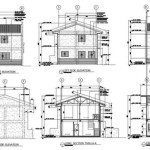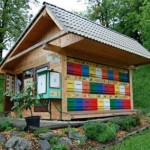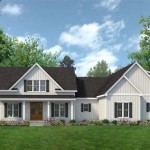Cool Single Story House Plans: Maximizing Space and Style
Single-story house plans, often referred to as ranch-style or rambler floor plans, have experienced a resurgence in popularity. Their accessibility, ease of maintenance, and adaptability to various lifestyles make them a compelling option for a diverse range of homeowners, including retirees, young families, and individuals with mobility limitations. These plans offer a unique blend of practicality and aesthetic appeal, often incorporating open floor plans, abundant natural light, and seamless transitions between indoor and outdoor living spaces. This article explores the key characteristics, advantages, and design considerations associated with cool single-story house plans.
The term "cool" in this context encompasses both functional and aesthetic aspects. A cool single-story house plan effectively utilizes space, incorporates modern design elements, and prioritizes energy efficiency. It is a design that resonates with contemporary sensibilities while providing comfortable and convenient living. The following sections will delve into specific elements that contribute to the "cool" factor and outline considerations for selecting the ideal single-story plan.
Accessibility and Universal Design Principles
One of the most significant advantages of single-story house plans is their inherent accessibility. The absence of stairs makes them ideal for individuals with mobility challenges, including those using wheelchairs or walkers. This accessibility extends beyond disability considerations. Single-story homes are also beneficial for families with young children, eliminating the risk of falls and simplifying everyday routines such as carrying groceries or laundry between floors.
Furthermore, single-story homes are well-suited for incorporating universal design principles. Universal design aims to create spaces that are usable by all people, to the greatest extent possible, without the need for adaptation or specialized design. This can include features such as wider doorways, lever-handled door hardware, roll-in showers, and adjustable-height countertops. Implementing these principles not only improves accessibility but also enhances overall convenience and safety for all occupants, regardless of age or ability.
The focus on accessibility often translates to a more open and fluid floor plan. Hallways are typically wider, and rooms are connected in a way that promotes ease of movement. This open layout contributes to a sense of spaciousness and fosters better social interaction within the home. Avoiding walls that restrict movement and visual connection are key considerations. This open concept also plays a significant role in the energy efficiency of the design.
Beyond the physical attributes of accessibility, the psychological impact of living in a single-story home should also be considered. Many individuals appreciate the sense of security and connection to the ground that these homes provide. The absence of a second story can also reduce feelings of isolation, especially for those who live alone. The ease of access to all areas of the home promotes a sense of independence and control, which can be particularly important for aging individuals.
Maximizing Space and Light in One-Story Living
A common misconception about single-story homes is that they are inherently smaller than multi-story dwellings. However, a well-designed single-story plan can effectively maximize space and provide ample living area. Key strategies for achieving spaciousness include open floor plans, vaulted ceilings, strategic window placement, and maximizing outdoor connections.
Open floor plans, which combine the living room, dining room, and kitchen into a single, interconnected space, are a hallmark of modern single-story design. This layout eliminates unnecessary walls, creating a sense of openness and flow. It also allows for better natural light penetration, reducing the need for artificial lighting during the day. The unified space encourages social interaction and makes it easier to entertain guests.
Vaulted ceilings are another effective way to enhance the feeling of spaciousness. By increasing the vertical dimension of a room, vaulted ceilings create a more airy and open atmosphere. They also allow for larger windows, further maximizing natural light. Clerestory windows, which are placed high on the wall, can be particularly effective in bringing light into the center of the home.
Strategic window placement is crucial for both maximizing natural light and creating visual connections to the outdoors. Large windows and sliding glass doors can be used to blur the lines between indoor and outdoor living spaces, extending the perceived area of the home. Consider the orientation of the house to maximize solar gain in the winter and minimize it in the summer. Skylights are also effective for bringing natural light into areas that may not have access to exterior walls.
Connecting indoor and outdoor spaces is a key element of many cool single-story house plans. Patios, decks, and porches can be seamlessly integrated into the design, creating outdoor living areas that are extensions of the interior. These spaces can be used for dining, relaxing, or entertaining, effectively increasing the usable living area of the home. Consider incorporating elements such as outdoor kitchens, fireplaces, and comfortable seating to create inviting and functional outdoor spaces.
Modern Design Elements and Energy Efficiency
Modern single-story house plans often incorporate sleek lines, minimalist aesthetics, and a focus on sustainable materials. These designs prioritize functionality and efficiency, both in terms of space utilization and energy consumption. Incorporating these elements can create a home that is both stylish and environmentally conscious.
Clean lines and simple forms are characteristic of modern design. This can be achieved through the use of neutral colors, minimal ornamentation, and a focus on geometric shapes. Large windows and sliding doors contribute to the modern aesthetic while also providing ample natural light and ventilation. Integrating these aspects with the indoor/outdoor flow helps reduce the environmental impact of the home.
Sustainable materials are increasingly important in contemporary home design. Consider using recycled or reclaimed materials, such as reclaimed wood flooring or recycled content countertops. Renewable materials, such as bamboo or cork, are also excellent choices. Selecting durable and low-maintenance materials will also reduce the environmental impact of the home over its lifespan.
Energy efficiency is a critical consideration for any modern home. Single-story homes are generally easier to insulate and seal than multi-story dwellings, making them more energy-efficient. Proper insulation, high-performance windows, and energy-efficient appliances can significantly reduce energy consumption. Consider incorporating passive solar design principles, such as orienting the house to maximize solar gain in the winter and minimize it in the summer.
Smart home technology can also contribute to energy efficiency. Smart thermostats, lighting controls, and automated window coverings can help regulate temperature and lighting, reducing energy waste. Solar panels can be installed on the roof to generate electricity, further reducing reliance on fossil fuels. The initial investment in these technologies can be offset by long-term energy savings and reduced environmental impact.
Water conservation is another important aspect of sustainable design. Low-flow toilets, showerheads, and faucets can significantly reduce water consumption. Rainwater harvesting systems can be used to collect rainwater for irrigation or other non-potable uses. Drought-tolerant landscaping can also reduce the need for irrigation.
In conclusion, cool single-story house plans offer a compelling combination of accessibility, spaciousness, and modern design. By prioritizing universal design principles, maximizing space and light, and incorporating sustainable materials and energy-efficient technologies, homeowners can create a home that is both functional and stylish. Careful planning and attention to detail are essential for achieving a successful single-story design that meets the needs and preferences of its occupants.

Stylish One Story House Plans Blog Eplans Com

Stylish One Story House Plans Blog Eplans Com

Unique One Story House Plans Monster

Elegant One Story Home 6994 4 Bedrooms And 2 Baths The House Designers

Unique One Story House Plans Monster

Three Bedroom Cool House Concept Home Design Plan Floor Plans

Must Have One Story Open Floor Plans Blog Eplans Com
Simple One Story Design Builder

Our Favorite Unique One Story House Plans Blog Dreamhomesource Com

Unique One Story House Plans Monster








